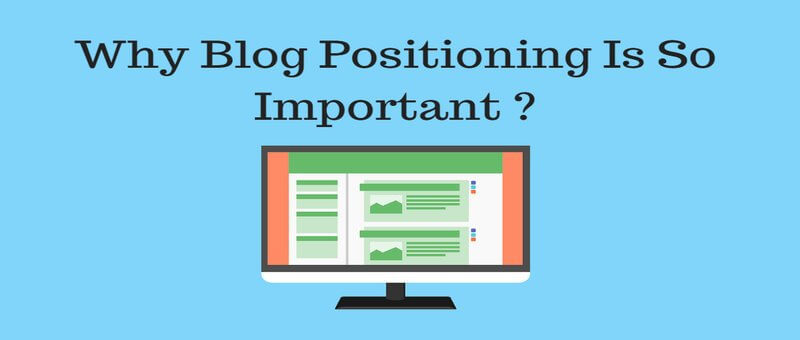How many times have you created a blog, thought it was great and felt people would be drawn to it only to find out that very few folks were even interested in it? You don’t understand why this is happening – why the traffic to your blog isn’t growing. Why you’re not getting the kinds of social shares that many other blogs seem to relish in. That's why you need a blog positioning strategy.
The reality is that professional marketers and bloggers know what’s important when it comes to content creation and developing products people love. And, if you want to be successful, you have to know it as well.
What’s The Secret That Every Successful Person Knows?
Think back to all the blogs you have read – what keeps you coming back to certain ones and ignore others? What motivates you to come back over and over again?
Popular blogs provide a good deal of content that have been geared toward their audience. They know the types of folks they’re talking to and develop material that resonates with them. The material they send sparks an emotional response – nothing happens accidentally. They’ve positioned their blog for their readers in just the right way.
Do you know if any readers that feel this way about your blog?
Blog Positioning: What Is It and How Does It Help Increase Readership To Yours?
In simple terms, blog positioning is a term used by marketers to learn the process of determining how your target audience is, what you can offer to them, how what you’re offering can affect them and how it’s different from your other products.
Think about your feelings for Starbucks, Target, Apple, brands of vehicles you’ve owned, etc. These companies work hard to connect with their customers on an emotional level. These brands, quite successful, have positioned themselves in a way that their messages and products/services spark an emotional response.
Blog positioning does not mean creating taglines or coming up with copy to be used. Instead, it reduces the audience to small slices, determines how your products/service are different from other companies and lets people know what the benefits are to using these things.
An Easy Positioning Formula You Can Follow


Now you understand why blog positioning is so important, but it’s time to figure out just how to do it. According to Crossing the Chasm author Geoffrey Moore, there is a positioning format that you should follow:
- For – Target audience
- Who – Audience with a problem
- Product – What is the product/service to problem
- Offers – What it can do for the audience
- Unlike – Make mention of a competitor
- Product/Service/Solution – Not the main point of difference
Amazon is one “prime” example of positioning. Back in 2001, Amazon was just a books-only online vendor. For Internet users who love reading books, Amazon.com is the best retail bookseller that offers immediate access to more than 1.1 million books. The difference between it and the traditional book retailers is that the website offers a mixture of low prices, superior convenience and an exhaustive selection.
Lexus’ positioning statement goes a little like this:
Affluent drivers who look for luxury vehicles that include reliability and superior quality can rest easy that Lexus only works with the best materials and technologies and provide vehicles with the quality control, so customers get a luxury vehicle experience.
How can you create a positioning statement that works for your business?
Learn Who Your Audience Is With Positioning
For
If you’re going to come up with a successful Blog Positioning Statement, you need to know one thing for sure: learn who your target customers or audience is. Are you gearing your material for middle-aged women, stay-at-home mothers, people looking for dates or bloggers?
From this point, go a little further by putting attention on their problems, hopes and concerns. You don’t have to get into the demographics of where your prospective audience is. What kinds of problems are they faced with? What can you address in your blog to help them “address” those problems?
Asking yourself these questions will help you to know who your sub-audience is – the people who really care about the things you have to say and offer.
In his blog post, Who Are Your Customers, Seth Godin said the following questions should be asked:
- Who does your audience believe?
- Who can they trust?
- What is your audience scared of?
- Who are they in love with?
- What is the audience looking for?
Along with his questions, there are three more you should consider asking:
- What keeps your audience up at night?
- What kinds of things do they dream about?
- What inspires your audience to take action?
When you answers the “For” questions, you can address the “Who” portion of the positioning statement.
Who
Now that you’ve gotten to the Who, you can write with a more clearly defined audience instead of a broad one. This is what turns a regular blog into a success – it establishes emotional connections.
Newbies stress about defining the niche process – worried that their blog won’t resonate with a bigger audience. But, you can explain who you are without excluding anyone. If you give your niche audience what they’re looking for, other readers will seek you out. They will share the elements you have.
Product Definition
After you’ve gotten your “for” and “who” blog positioning details out of the way, it’s time to explain the features of your product. This is rather easy. For instance, Dyson is a lightweight, easy-to-use vacuum cleaner that won’t lose its section.
Product Offerings
When it comes to a blog, this positioning will note what your readers take away from reading it. For example, Bizwebjournal may have something to the effect that it helps newbie Internet entrepreneurs and bloggers begin their careers and launch successful products and move past the traditional marketing obstacles standing in its way.
Differentiation
An effective positioning statement is one that separates your product from your competitors; ensuring you establish the product’s value. Dyson’s positioning statement is that the vacuum won’t lose the suction – setting itself apart from Bissell and Hoover.
When it comes to blogging, you need to understand your readers have an array of choices they can choose from. What blogs are you in competition with? Why should readers pick your blog over theirs?
The Internet and social media have ensured your message reaches your audience. Thus, your audience can find so many other blogs to get their news from.
This doesn’t need to be a daunting process. Although you face an array of competitors, your unique voice, take and connection to your readers’ challenge is what will set you apart from the competition.
Differentiation isn’t about credentials – people are not going to read or share posts based on your credentials. You want them to read and share it because it offers something different other blogs don’t offer.
Effective Positioning Statement Puts Attention On The Advantages
All effective positioning statements put attention on a product’s advantages – not just its features. Products, where the focus is on features, tend to have problems staying relevant. Why? Other companies will come out with something better – brighter screen, longer, battery life, bigger engine, etc.
If you lay out what the advantages are, it’ll be more appealing to your audience and their desire, sparking emotions. What are some of the benefits you could highlight? They include safety, more money, more time, etc. Or, the benefits could be perceived such as the cool factor of owning a product. Apple enthusiasts always wait in line for when the company is releasing an updated iPhone because owning one gives them the feeling of coolness.
Of course, if you’re a writer, you don’t have a tangible product, but the benefits are still there. You need to spark emotions with your readers – look to aspire them, to give them hope. You want them to benefit from your content. How can you assist them to act another way and solve their issues?
Jon Morrow, a blogger and blogging instructor, advises others to think of their possible readers as the walking dead. This means reaching into their dreams, desires, and fears. If you can address their issues, you have established some emotional connections. It makes the walking dead come alive.


It’s Time To Have Positioning Work For You
This is the moment to try positioning for your blog and/or products. If you use the above structure, you can establish a connection with your readers and lay out the advantages you’ll give them.
My blog has something like this:
For – People who are ready to take the step to become online entrepreneurs
Who – People who want to grow their business quickly
StartLaunchGrow – A regular amount of care, incentive, curation, entertainment and learning
Provides – A safe community of innovative learning as well as tangible tools and examples to assist with marketing, sales and product development
Unlike – Focuses on “What” to assist readers with the why, who and how
Our Tools and Blog – Inspire and help new business owners with business guidance and emotional support.
When you position your blog, you may have to do it several times. Be sure you read it several times and ask someone you trust to look through it as well.
And, if you’re not sure about things, here’s something to ask yourself, “What kind of emotions do I want my readers to have after they’ve read my posts?”
It’s All About Being Smart
Do you want to reach deep inside your readers and spark their emotions? Do you want to become the Starbucks they can’t do without? It’s not just taglines that make Apple, Starbucks, Amazon or Target successful; it’s knowing what makes their users feel something and make them feel how their companies want them to feel.
It’s time for you to use the blog positioning method for yourself; to generate a connection with your readers – make them become your biggest fans and refer others to your blog too.
Paraphrasing Charles de Lint, "nobody can see the world like you do, which means nobody can tell the stories you can tell".
Did you position your blog in the right way? Please let us know in the comments below.


